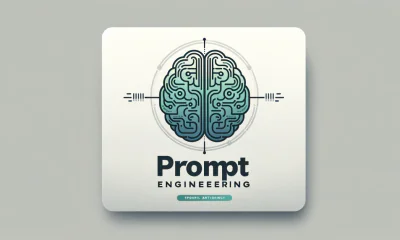Prompt Engineering
What is Prompt Tuning?

Prompt tuning involves crafting and inputting a carefully designed text “prompt” into a Large Language Model (LLM). This prompt essentially guides the model's response, steering it toward the desired output style, tone, or content. Unlike traditional model training, which requires retraining the model on a large dataset, prompt tuning only needs a small set of examples or even a well-constructed sentence to influence the model's behavior.
How Prompt Tuning Works
- Designing the Prompt: This step is crucial and requires an understanding of the model's capabilities and the task at hand. The prompt should be clear, concise, and aligned with the desired output.
- Inputting the Prompt: The prompt is fed into the LLM. The model uses this as a context or a starting point for generating its response.
- Generating the Output: The model processes the prompt and produces an output that aligns with the guidance provided by the prompt.
Prompt Tuning Examples
By adjusting the initial prompt, the output of the model can be significantly altered to suit specific needs or contexts. Below are examples of original prompts and their refined versions through prompt tuning:
Example 1: Content Creation
- Original Prompt: “Write a story about a dragon.”
- Tuned Prompt: “Write a humorous story about a friendly dragon who loves baking cookies and lives in a magical forest.”
Explanation:
The original prompt is broad and could lead to various types of stories about dragons. The tuned prompt, however, specifies the tone (humorous), the nature of the dragon (friendly and baking cookies), and the setting (magical forest), guiding the LLM to generate a more specific and tailored story.
Example 2: Professional Email
- Original Prompt: “Draft an email for a project update.”
- Tuned Prompt: “Draft a formal email to a senior manager providing a concise update on the XYZ project, focusing on recent milestones and next steps.”
Explanation:
While the original prompt is quite general, the tuned version specifies the audience (senior manager), the project (XYZ), and the content focus (recent milestones and next steps), ensuring a more targeted and appropriate email for a corporate environment.
Example 3: Educational Material
- Original Prompt: “Explain photosynthesis.”
- Tuned Prompt: “Explain photosynthesis in simple terms for a 5th-grade science class, including the role of sunlight, water, and carbon dioxide.”
Explanation:
The original prompt could lead to a wide range of explanations suited for different knowledge levels. The tuned prompt, however, tailors the explanation for a specific audience (5th graders) and highlights key elements to be included (sunlight, water, carbon dioxide), making it more suitable for an educational context.
Example 4: Technical Support
- Original Prompt: “How to fix a router?”
- Tuned Prompt: “Provide a step-by-step beginner-friendly guide on how to troubleshoot and fix common issues with a home Wi-Fi router, including restarting the router and checking cable connections.”
Explanation:
The original prompt is open-ended and could lead to a variety of solutions. The tuned prompt narrows down the response to a beginner-friendly, step-by-step guide, focusing on common issues and basic troubleshooting methods, which is more practical for non-technical users.
Example 5: Recipe Generation
- Original Prompt: “Give me a chicken recipe.”
- Tuned Prompt: “Provide a healthy grilled chicken recipe suitable for a ketogenic diet, including ingredients like fresh herbs and olive oil, and avoiding sugars and carbs.”
Explanation:
The original prompt could result in any type of chicken recipe. The tuned prompt, however, specifies the dietary requirement (ketogenic), cooking method (grilled), and preferred ingredients (fresh herbs, olive oil), while also mentioning what to avoid (sugars, carbs), leading to a more targeted recipe suggestion.
Example 6: Travel Advice
- Original Prompt: “Suggest a travel destination.”
- Tuned Prompt: “Recommend a travel destination for a family with young children, focusing on places with educational value and kid-friendly activities in Europe.”
Explanation:
The tuned prompt narrows the focus to family-friendly destinations in Europe, with an emphasis on educational and kid-friendly activities, providing a more tailored travel recommendation for families with young children.
Example 7: Fitness Guidance
- Original Prompt: “Give me a workout routine.”
- Tuned Prompt: “Design a 30-minute home workout routine for beginners, focusing on bodyweight exercises that improve cardiovascular health and require no equipment.”
Explanation:
Instead of a generic workout routine, the tuned prompt specifies a 30-minute, equipment-free routine for beginners, focusing on bodyweight exercises to enhance cardiovascular health, making it more suitable for those new to fitness or limited by space or equipment.
Example 8: Language Learning
- Original Prompt: “Teach me Spanish.”
- Tuned Prompt: “Provide a basic lesson in Spanish for beginners, focusing on common phrases for travelers like greetings, directions, and ordering food.”
Explanation:
The tuned prompt directs the LLM to create a beginner-level Spanish lesson specifically tailored for travelers, concentrating on practical phrases related to greetings, directions, and ordering food, which is more applicable for someone planning to travel.
Example 9: Job Interview Preparation
- Original Prompt: “How should I prepare for a job interview?”
- Tuned Prompt: “Outline key strategies for preparing for a job interview in the tech industry, including tips on discussing programming skills and past software projects.”
Explanation:
The tuned prompt focuses on interview preparation for the tech industry, with specific emphasis on discussing programming skills and software project experience, thus providing more relevant advice for aspiring tech professionals.
Example 10: Environmental Awareness
- Original Prompt: “Write about climate change.”
- Tuned Prompt: “Compose an informative article on the impact of climate change on ocean ecosystems, highlighting the effects on marine life and coral reefs.”
Explanation:
Rather than a broad article on climate change, the tuned prompt requests an article focused on its impact on ocean ecosystems, specifically the effects on marine life and coral reefs, providing a more specialized and insightful perspective on the topic.
Key Takeaways from Examples
These examples illustrate the effectiveness of prompt tuning in refining the output of LLMs. By providing detailed and contextually relevant prompts, the responses can be tailored to address specific requirements and audiences, enhancing the utility and precision of the generated content.
Advantages of Prompt Tuning
- Resource Efficiency: It eliminates the need for extensive computational resources usually required for full-scale model training.
- Task Specificity: Enables the customization of general-purpose LLMs for specific tasks without altering the underlying model.
- Speed: Prompt tuning can be implemented quickly, making it ideal for rapid development cycles.
Applications of Prompt Tuning
1. Content Creation: Creative Writing, Journalism, or Advertising
- Creative Writing: Prompt tuning can guide AI to generate narratives, poems, or scripts with specified themes, styles, or character development. For instance, prompts can be tuned to produce a romantic comedy script or a fantasy novel with specific plot elements.
- Journalism: In journalism, prompt tuning helps in generating articles or reports tailored to a specific news genre or audience. For example, prompts can be designed to create an in-depth investigative report on environmental issues or a brief news summary for a local community bulletin.
- Advertising: For advertising, prompt tuning can create targeted ad copy that resonates with a specific demographic or aligns with a brand’s voice. Advertisers can tune prompts to generate content for a youthful, energetic product campaign or a sophisticated, luxury brand promotion.
2. Customer Service: Chatbots in Specific Industries:
- Industry-Specific Queries: Prompt tuning can enable chatbots to understand and respond to queries specific to industries like finance, healthcare, or travel. For example, a chatbot for a bank can be tuned to assist with account inquiries, while one for healthcare might focus on appointment scheduling and general health questions.
- Tone and Branding: Beyond just industry knowledge, prompt tuning can adjust the tone of the chatbot to match a company's branding – be it professional and formal for legal services or friendly and casual for a retail business.
3. Language Translation: Cultural Nuances and Industry-Specific Terminologies
- Cultural Sensitivity: Prompt tuning can help translation models consider cultural nuances, idioms, and local expressions, ensuring translations are not just linguistically accurate but also culturally appropriate.
- Technical Accuracy: In sectors like law, medicine, or engineering, prompt tuning can ensure that translations accurately reflect industry-specific terminologies, crucial for technical documents or professional communications.
4. Educational Tools: Study Aids Aligned with Curricula or Teaching Styles
- Curriculum-Specific Learning: Prompt tuning can generate educational content aligned with specific curricula, such as creating practice problems for a high school algebra course or discussion questions for a college-level history class.
- Adaptive Learning Styles: Different teaching styles can be incorporated through prompt tuning, whether it's generating interactive, exploratory questions for inquiry-based learning or detailed explanations for a more traditional teaching approach.
Summary
While prompt tuning is powerful, it's not without challenges. Crafting effective prompts requires skill and an understanding of the model's functioning. Additionally, there's the risk of the model generating biased or undesirable content, depending on the nature of the prompt.
Prompt tuning enhances the versatility of AI models, enabling them to produce content that is not only contextually relevant but also aligned with specific user needs and preferences across various domains. This customization capability is crucial in sectors where the accuracy of information and the nuance of presentation are key, making AI tools more effective and user-friendly.














